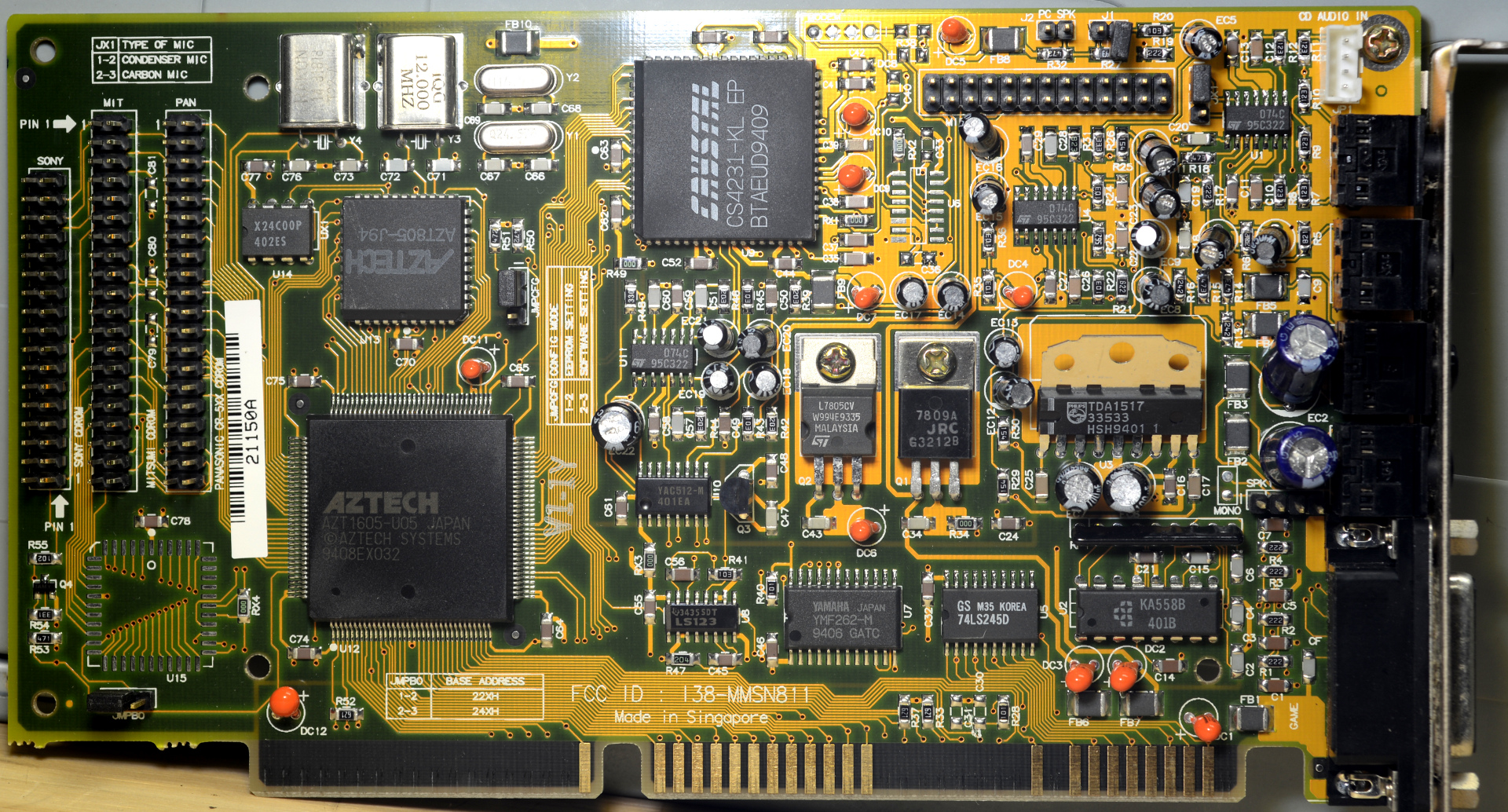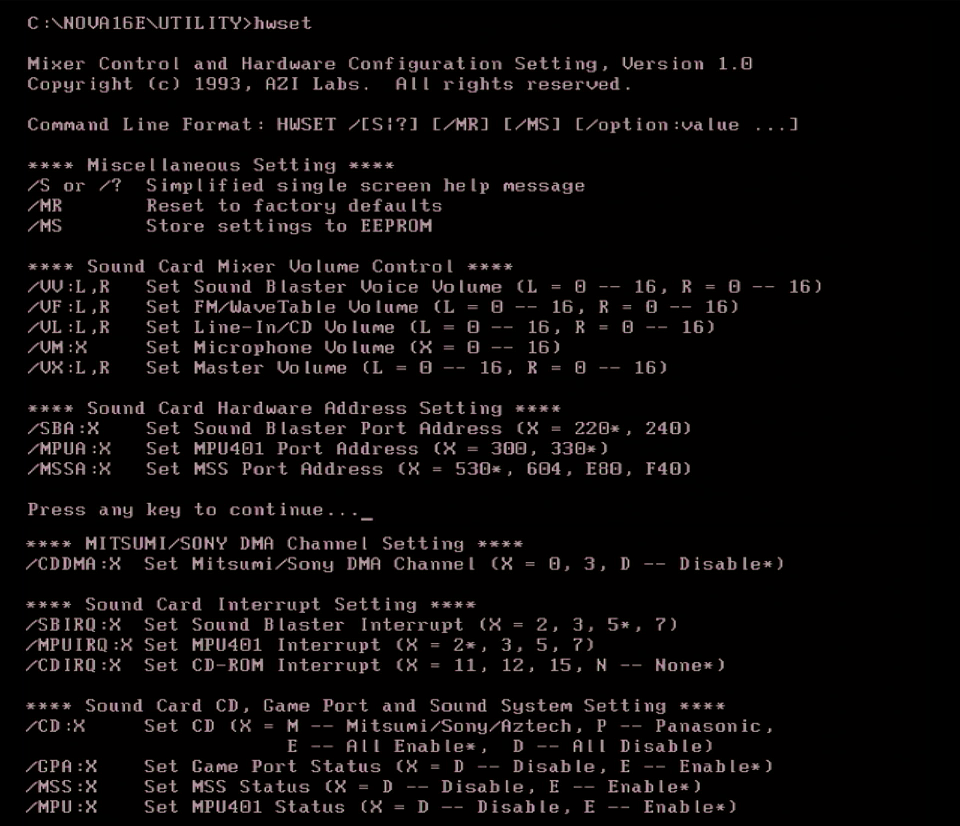Aztech Sound Galaxy Nova 16 / Nova 16 Extra
In 1994, Aztech released the first of their 2nd-generation cards, the Sound Galaxy Nova 16. They dropped support for the Covox and Disney from here on in.
|
Released | 1994 |
| Bus | ISA 16-bit | |
| FM Synth | Yamaha YMF262 (OPL3) or LS-212 | |
| Audio Codec | Crystal CS-4231-KL | |
| Chipset | AZT-1605-U05 (2nd generation chip) | |
| Standards | Ad Lib, Sound Blaster, Sound Blaster Pro 2, Windows Sound System | |
| Ports | Speaker-Out, Mic-In, Line-In (stereo), Line-Out (stereo), Game port |
|
| CD-ROM | Sony, Panasonic and Mitusmi | |
| Wavetable | Yes, Wave Blaster-compatible | |
| Plug & Play | No (but does use Auto-Init for DMA) | |
| FCC ID(s) | I38-MMSN815 (Nova 16), I38-MMSN811 (Nova 16 Extra) | |
| Price | - | |
| See Also | Sound Galaxy Pro 16 II |
The Nova 16 was the first Aztech card to come with their 2nd-generation audio chipset: AZT-1605-U05, internally codenamed "Clinton" (Aztech used U.S. Presidents surnames for their chip families; their later family was codenamed "Washington"). This 2nd generation dropped support for the Covox Speech Thing and Disney Sound Source, leaving just Ad Lib, Sound Blaster Pro 2.0 and Windows Sound System. Despite losing some things, the MIDI interface was now fully MPU-401 UART compatible. On the negative side, this chipset is rumoured to *not* support Sound Blaster 2.0 under DOS (see my full review for more information).
Aztech also released the Nova 16 Extra - the 'Extra' moniker really means nothing as far as the card's capabilities go - it was more likely a hardware and software bundle including powered speakers. Nova 16 had a part number of I38-MMSN815 while the 'Extra' had part number I38-MMSN811.
The Nova 16 sound card was also bundled with two of Aztech's 'multimedia upgrade kits' that were very common around the mid-90s when everyone was talking multimedia as the latest buzzword and bandwagon to jump on. The kits that included Nova 16 were called 'Sound Galaxy Asteroid Multimedia Kit' and 'Sound Galaxy Voyager Multimedia Kit', priced at $349 and $399 respectively. Both came with a CDA 268-01A double-speed CD-ROM drive, but Asteroid got 4 bundled titles while Voyager got 7.
I did a full review of this card in October 2021. You can also c![]() ompare the audio output of the Nova 16 Extra side-by-side with numerous other sound cards in my Sound Blaster 16 CT2770 Retro Review.
ompare the audio output of the Nova 16 Extra side-by-side with numerous other sound cards in my Sound Blaster 16 CT2770 Retro Review.
SoftMPU apparently locks up when used with cards that have the AZT-1605 chipset.
The Nova 16 Extra is directly supported in Voyetra's Sequencer Plus Gold.
The Nova 16 was OEM'd by Packard Bell (model 030053) as the Forte 16SBP, Reveal (SC400 revision 3) and others (often identifiable by the OEM's sticker on the lower-left main chip).
The wavetable header is Wave Blaster-compatible.
The MIDI/game port is MPU-401 compatible.
Board Revisions
I have no information on the various board revisions for the Nova 16 or Nova 16 Extra.
Competition
In 1994, Creative Labs were into their second generation of Sound Blaster 16s and the AWE32 had just been released. This would have meant cards like this Aztech Nova 16 fell into the budget segment. Aztech would continue their strong relationships with OEMs as their primary sales channel for such cards as this. As mentioned, the multimedia boom was upon us, so those looking to install their first CD-ROM drive may have bought one of Aztech's retail multimedia upgrade kits that included this card.
Those with deeper pockets (such as those who could afford an AWE32) may have chosen one of the many alternative high-end cards that arrived in 1994 such as the MediaVision Pro 3D / Premium 3D, Ensoniq SoundScape, MediaTrix AudioTrix Pro, or the Turtle Beach Tahiti / Monterey.
In the Media
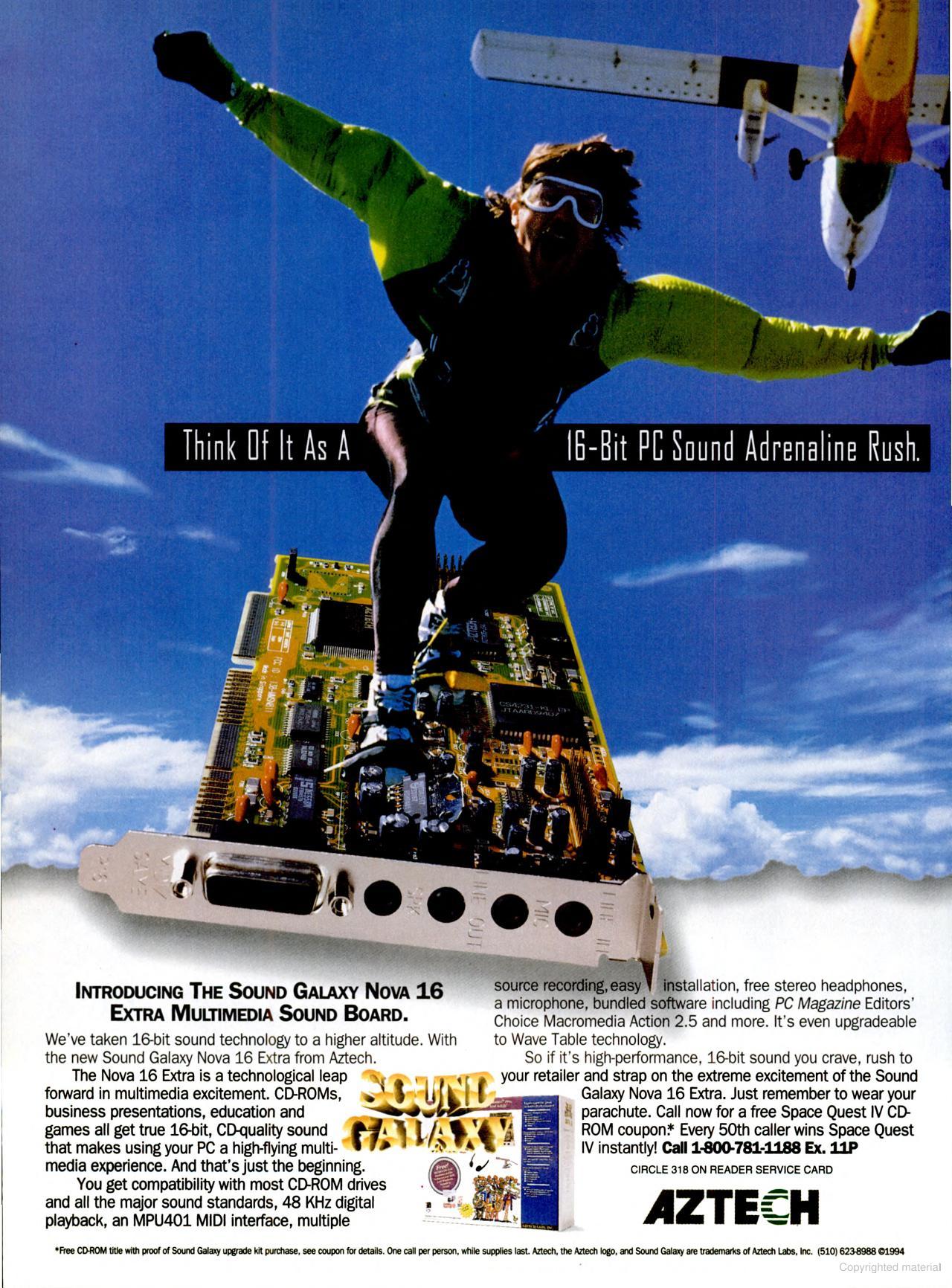
An advert for the Aztech Sound Galaxy Nova 16 Extra (July 1994)
Setting it Up
The base address can be chosen via jumper, but other changes must be chosen via the Aztech configurator software.
There is a configurator that works in plain DOS, but it's hidden inside the Windows driver package which can't be extracted under DOS! If you install the Windows 3-floppy package below, you'll find a file called HWSET.EXE in the Utility directory of the NOVA16E directory. Note that Aztech had several different 'hwset' utilities and they are not cross-compatible between cards!
This is the one program you need to get the card intialized and configured under pure DOS:
You can also use the CONFIG.EXE tool (also in the UTILITY subdirectory) to guide you through configuring the card. Neither of these methods write to your CONFIG.SYS or AUTOEXEC.BAT files - the config is stored on the card itself.
Downloads
More Pictures
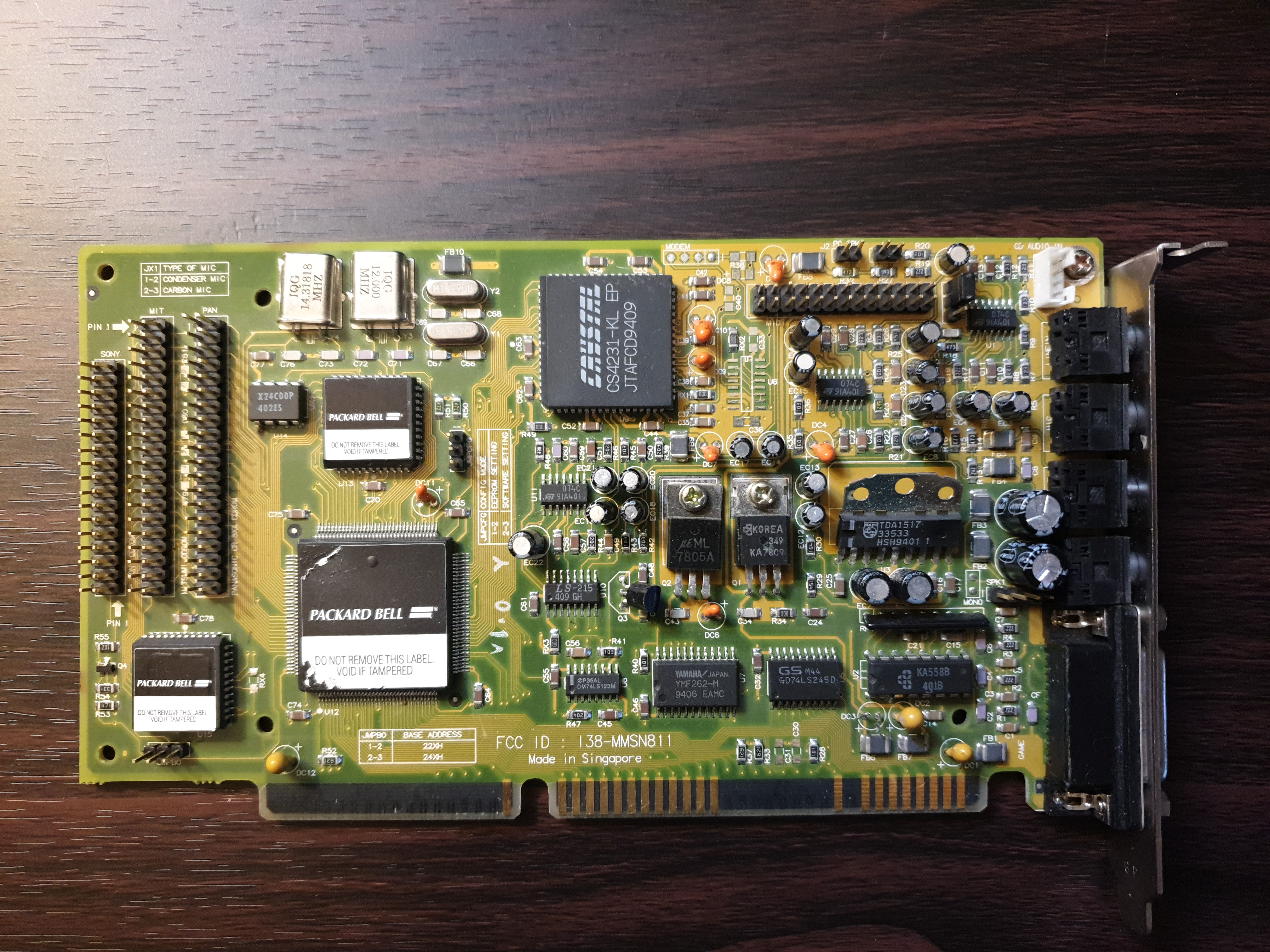
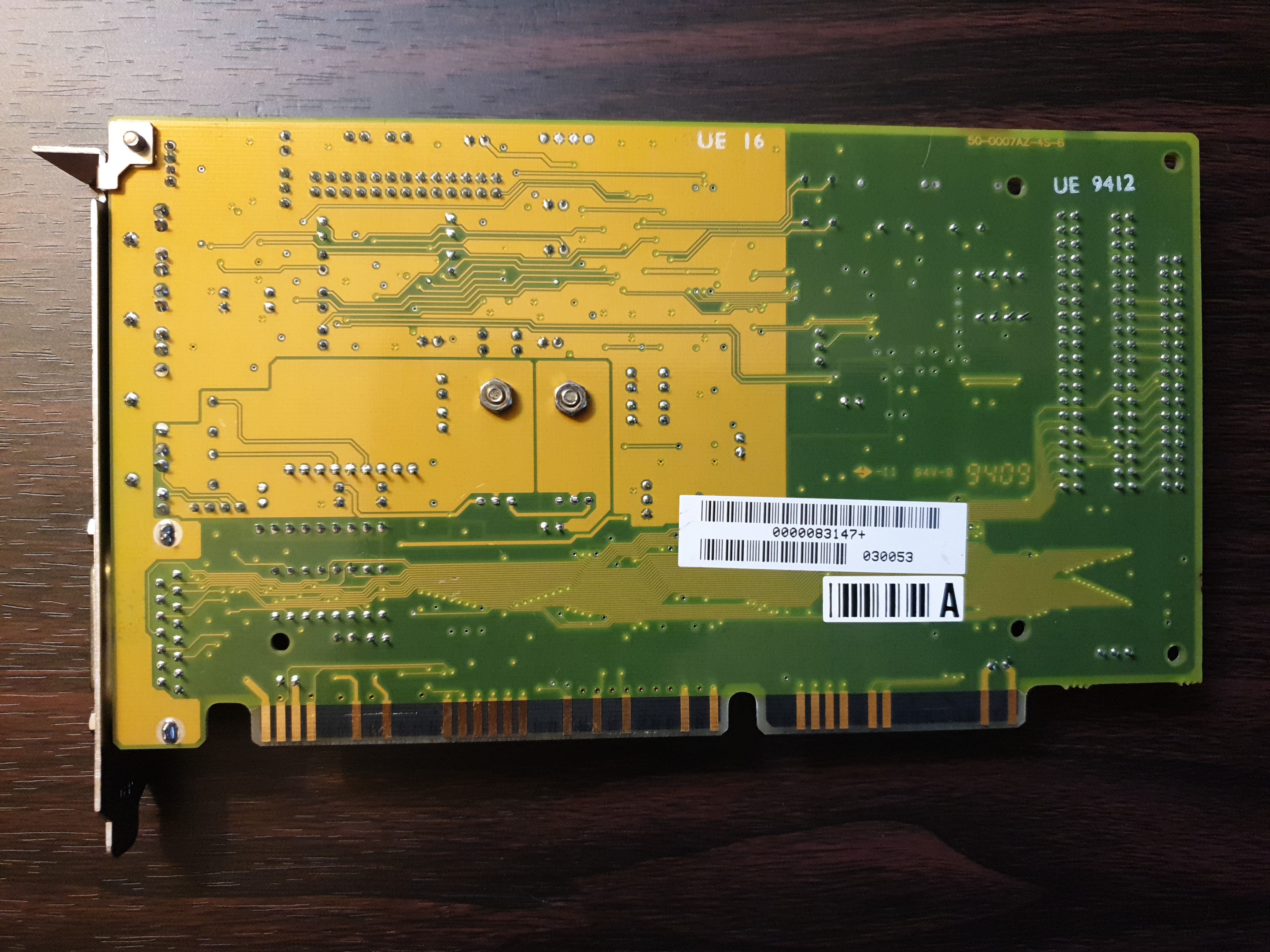
My Aztech Sound Galaxy Nova 16 Extra (I38-MMSN811) from 1994
